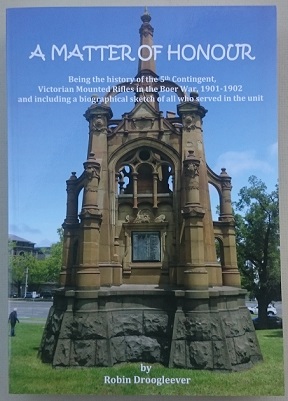Dr Robin Droogleever is a founding member of the Anglo Boer War Study Group and has been its President for more than two decades. A Matter of Honour is the third volume of a trilogy that covers the history of all five contingents of the Victorian Mounted Rifles who fought in the Boer War between 1899 and1902.

Paperback 666 pp RRP: 60.00 (plus postage)
Over 4000 men answered the call to Victoria Barracks, Melbourne in early January 1901 when the Fifth Contingent (of 504 men, plus regimental staff and 524 horses) was to be raised. Victoria then offered to raise a Sixth Contingent for Lord Kitchener – this was accepted, but the logistic strain, shortage of officers and non-commissioned officers, saw the two contingents were merged into the Victorian Fifth Contingent. Departing 15th February, after rudimentary training at Langwarrin, the Contingent arrived without incident in Capetown on 8th March before moving to eventually arrive in Pretoria on 23rd March.
The first action seen and casualties sustained was on 16th April. In May the Contingent was divided into two columns (Left and Right Wings) – each of four companies. On June 12th, the Left Wing under command of (British) Major Morris of the Royal Artillery settled in for the night at Wilmansrust farm, when a small Boer force overran the far stronger VMR, killing 18 and 48 wounded for a loss of only six killed and four wounded. In the almost immediate Inquiry, the Column commander, (British) Major General Stuart Beatson, who had publicly called the 5th VMR ‘a fat-arsed, useless lot of wasters’ (maximum weight for recruits was 12 stone, i.e. 76kg!) and ‘white-livered curs’ ensured that the only aspect of events examined was the actions of the men comprising the four pickets placed around the camp. Those Imperial officers in command and their tactical decisions and lack of orders were never even considered. This defeat has tainted the reputation of 5 VMR until today, and Droogleever has set out to balance the ledger. Beatson eventually offered an apology, but the damage had been done. He was soon to be moved on.
The men of 5 VMR were then itching to demonstrate they were as good as any other horsemen, and under a new commander in Colonel William Pulteney (Scots Guards) acquitted themselves well in Natal and southeast Transvaal at Hlobane (27 August), Bedrog Farm (5 Nov), Geelhoutboom (23 Nov) and Glenfillan (23 Dec). Lieutenant Leslie Maygar (born near Kilmore) was awarded the VC for his actions on 23 Nov. Honour had at last been restored. The Contingent left South Africa on 23 and 24 March, arriving in Melbourne on 25 and 26 April 1902. Its members paid for the erection of their own Memorial (seen above in front of Victoria Barracks).
Forty percent of the 5 VMR members enlisted in the AIF in World War I, with another VC and other high awards coming their way, so lack of commitment and bravery should have no longer been pointed at them.
This work is monumental in scope. With over 750 footnotes to the text indicating the depth of research, the narrative is a virtual journal with eyewitness accounts from both sides providing incredible detail. Generous numbers of maps, diagrams and photographs of sites, key personnel, those men killed and wounded (and sometimes their final resting place) ensure the reader misses no aspect of this incredibly difficult and demanding campaign.
Nine appendices include the speculation about events at Wilmansrust, the role of the press back here in Victoria, the building of the 5th VMR Boer War Memorial, the fate of those permanently wounded, Service Awards, World War I service by members and the Roll of Honour. 200 pages of biographical details of all ranks follow the appendices. A further 150 pages are devoted to portraits of the men, and a picture gallery of the men before, during and after serving in South Africa. A comprehensive Bibliography and Index complete this work.
It is not surprising that Robin is considered the expert on the Boer War period. This volume, together with Colonel Tom’s Boys: 1 & 2 Contingent VMR (2013) and That Ragged Mob: 3 & 4 Contingent VMR (2009) provide almost encyclopedic coverage of Victoria’s commitment to the Boer War, and should well serve the descendants of these horsemen and soldiers as well as occupying a vital niche in any military history collection.
[A Matter of Honour is available from the author at jerwfd@optusnet,com,au]
Reviewed for RUSIV by Neville taylor, June 2017
Contact Royal United Services Institute about this article.






